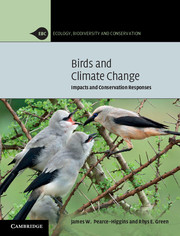Book contents
- Frontmatter
- Dedication
- Contents
- Foreword
- Acknowledgements
- 1 Birds and climate change
- Part I Impacts
- Part II Conservation responses
- 6 Using models to predict the effects of climate change on birds
- 7 Conservation in a changing climate
- 8 Effects of climate change mitigation on birds
- 9 Overall conclusions
- References
- Index
7 - Conservation in a changing climate
Published online by Cambridge University Press: 05 June 2014
- Frontmatter
- Dedication
- Contents
- Foreword
- Acknowledgements
- 1 Birds and climate change
- Part I Impacts
- Part II Conservation responses
- 6 Using models to predict the effects of climate change on birds
- 7 Conservation in a changing climate
- 8 Effects of climate change mitigation on birds
- 9 Overall conclusions
- References
- Index
Summary
Introduction
Climate change is anticipated to result in species shifting their distribution to higher latitudes and altitudes (Chapter 6), as has already been observed (Chapter 5). Changes to habitats, and the abundance of food organisms, predators, competitors, parasites and diseases, and the direct effects of climate will alter species’ demographic rates and abundance (Chapters 3 and 4). In parts of the range where population density increases, this is likely to result in an increasing number of dispersing individuals being available to colonise areas of habitat beyond the current range margin. At the retreating range margin, conditions are likely to become increasingly unfavourable, resulting in reduced fecundity and/or survival. Initially, as population density declines, negative effects of climatic change on a particular demographic rate may be at least partially compensated for by density-dependent improvements in other rates. The population in this part of the range may then stabilise at a lower level for some time. However, progressive change will eventually cause population declines, fragmentation of the distribution, local extinctions and finally loss of range. Between the expanding and retreating margins, the same mechanisms may lead to shifts in the distribution of areas with high population density, and changes to the composition of communities (Chapter 5).
Observations of impacts of climate change, and concerns over the impacts projected to come, have stimulated increasingly detailed thinking about what conservationists can do to counter negative impacts through what is termed climate change adaptation: interventions to reduce the vulnerability of species and their habitats to actual or expected climate change effects. Recent advances in conservation science have provided an increased understanding of the precise requirements of species and the impacts upon them of threats such as habitat loss and degradation, overexploitation, persecution and pollution, all driven by expanding human populations and their increased demands for food, recreation and commodities. This understanding has underpinned some successful conservation programmes that have reversed population declines and range losses of some species. We therefore start this chapter with a summary of the tools that conservationists have found to be effective in countering these threats to birds, before considering how they may be adapted for use in the face of climate change.
- Type
- Chapter
- Information
- Birds and Climate ChangeImpacts and Conservation Responses, pp. 250 - 307Publisher: Cambridge University PressPrint publication year: 2014

